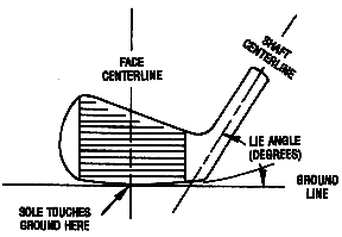
We all know that Golf is a game that's difficulties can induce high levels of frustrations. So the one piece of advice we have is to make sure you have the right equipment. Don't make it more difficult for yourself by using clubs that just don't feel right.
Every golfer's body and swing are unique to that individual and that's what custom fitting is all about. Custom fitting golf clubs involves a quick self assessment of your game and several easy measurements. To custom fit your golf clubs, the following information is needed:
• Your gender (male or female)
• Your height in your stockings or socks
• The distance from your wrist (where it bends) to the floor (without shoes)
• What club you use at the 135 meter marker
• Handicap, age, swing speed
Firstly, your gender is used to put you into the correct fitting scale. Then, your height and the distance in inches from your wrist to the floor are used together to determine the length of golf club that is appropriate for you. (About 80% of golfers are Standard length.)
Your age, handicap, estimated golf swing speed and club you use at the 135 meter marker are all combined to determine the shaft flex that is appropriate for you.
Club Length & Flex
With regards to the length of your club there's one main point you should consider: a longer golf club will hit further given the same swing speed - so length can be a good thing. But, as I'm sure you're thinking, it can't be that simple. And you're right! Since the swing arc is longer, it often is also harder to keep under control - so length can be a bad thing. All things being equal, most golfers will opt for longer length to the sacrifice of greater control. But there's still a decision to be made!
The standard length of a steel shafted Driver for a man is 44 inches. Graphite shafted drivers are manufactured 1 inch longer than steel shafted clubs because graphite shafts weigh less than steel shafts allowing us to produce a longer club with the same swing . The proper length of a golf club is a function of your height and the length of your arms. Some golf shop provide a Custom Fitting Wizard that determines the correct length for you with just a few simple measurements.
Flex is the torsional stiffness of the golf club, which is provided by the type of golf club shaft that is used. Generally, stiffer shafts are better for stronger hitting golfers.
The proper flex of a golf club is a function of your strength and golfing skills. Determining the correct flex is most important for your Woods and longer Irons. Short irons, wedges and putters are not impacted very much by the different flexes as the differences between flexes becomes very small in the shorter clubs.
Loft & Lie Adjustments
A lie adjustment requires bending the hardened metal in which an iron is cast. We strongly advise getting your lie fitting done in person. Online fittings while accurate do not take into account your natural ball address. Some players are more naturally upright and some like to lean into the ball. Once you have lie adjusted a club it is usually not a good idea to re-adjust if you later find it was the wrong adjustment.
From years of building experience we find it rare to need more than a 2 degree adjustment upright or flat, therefore we only perform lie adjustments to either extreme.
Woods, hybrid clubs and putters can not be adjusted. The reason these clubs can not be adjusted is because the hosel of each is cast in a way where physically bending the head at all will cause damage. In woods and hybrids it will crack or bend the crown of the club, and putter hosels are not made with the strength required for adjustment after the casting process.
Loft adjustments require a different type of bend than a lie adjustment. Some people receive advice in which they require a certain loft adjustment. We have never understood loft adjustments since it merely changes the loft of the club. We recommend buying golf clubs matching the loft you seek and avoid custom loft adjustments. Bending the loft of an iron weakens the hardened metal and can lead to future metal fatigue, since the actual bend twists the metal to an extent. If the loft of your 5 iron is too strong, use a 6 iron. If it is too weak, use a 4 iron.
Article by: Lind Golf
Photo by: TWOG.com
Every golfer's body and swing are unique to that individual and that's what custom fitting is all about. Custom fitting golf clubs involves a quick self assessment of your game and several easy measurements. To custom fit your golf clubs, the following information is needed:
• Your gender (male or female)
• Your height in your stockings or socks
• The distance from your wrist (where it bends) to the floor (without shoes)
• What club you use at the 135 meter marker
• Handicap, age, swing speed
Firstly, your gender is used to put you into the correct fitting scale. Then, your height and the distance in inches from your wrist to the floor are used together to determine the length of golf club that is appropriate for you. (About 80% of golfers are Standard length.)
Your age, handicap, estimated golf swing speed and club you use at the 135 meter marker are all combined to determine the shaft flex that is appropriate for you.
Club Length & Flex
With regards to the length of your club there's one main point you should consider: a longer golf club will hit further given the same swing speed - so length can be a good thing. But, as I'm sure you're thinking, it can't be that simple. And you're right! Since the swing arc is longer, it often is also harder to keep under control - so length can be a bad thing. All things being equal, most golfers will opt for longer length to the sacrifice of greater control. But there's still a decision to be made!
The standard length of a steel shafted Driver for a man is 44 inches. Graphite shafted drivers are manufactured 1 inch longer than steel shafted clubs because graphite shafts weigh less than steel shafts allowing us to produce a longer club with the same swing . The proper length of a golf club is a function of your height and the length of your arms. Some golf shop provide a Custom Fitting Wizard that determines the correct length for you with just a few simple measurements.
Flex is the torsional stiffness of the golf club, which is provided by the type of golf club shaft that is used. Generally, stiffer shafts are better for stronger hitting golfers.
The proper flex of a golf club is a function of your strength and golfing skills. Determining the correct flex is most important for your Woods and longer Irons. Short irons, wedges and putters are not impacted very much by the different flexes as the differences between flexes becomes very small in the shorter clubs.
Loft & Lie Adjustments
A lie adjustment requires bending the hardened metal in which an iron is cast. We strongly advise getting your lie fitting done in person. Online fittings while accurate do not take into account your natural ball address. Some players are more naturally upright and some like to lean into the ball. Once you have lie adjusted a club it is usually not a good idea to re-adjust if you later find it was the wrong adjustment.
From years of building experience we find it rare to need more than a 2 degree adjustment upright or flat, therefore we only perform lie adjustments to either extreme.
Woods, hybrid clubs and putters can not be adjusted. The reason these clubs can not be adjusted is because the hosel of each is cast in a way where physically bending the head at all will cause damage. In woods and hybrids it will crack or bend the crown of the club, and putter hosels are not made with the strength required for adjustment after the casting process.
Loft adjustments require a different type of bend than a lie adjustment. Some people receive advice in which they require a certain loft adjustment. We have never understood loft adjustments since it merely changes the loft of the club. We recommend buying golf clubs matching the loft you seek and avoid custom loft adjustments. Bending the loft of an iron weakens the hardened metal and can lead to future metal fatigue, since the actual bend twists the metal to an extent. If the loft of your 5 iron is too strong, use a 6 iron. If it is too weak, use a 4 iron.
Article by: Lind Golf
Photo by: TWOG.com


 RSS Feed
RSS Feed
